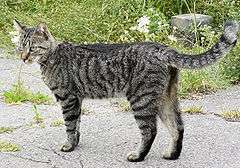Felis
| Felis Temporal range: Messinian - Holocene 7–0 Ma | |
|---|---|
 | |
| Wildcat, Felis silvestris | |
| Scientific classification | |
| Kingdom: | Animalia |
| Phylum: | Chordata |
| Class: | Mammalia |
| Order: | Carnivora |
| Family: | Felidae |
| Subfamily: | Felinae |
| Genus: | Felis Linnaeus, 1758 |
| Species | |
 | |
| Native Felis range | |
Felis is a genus of small and medium-sized cat species native to most of Africa and south of 60° latitude in Europe and Asia to Indochina.[1]
Results of genetic studies indicate that Felis, Otocolobus and Prionailurus diverged from a Eurasian progenitor about 6.2 million years ago, and that Felis species split off 3.04 to 0.99 million years ago.[2][3]
This genus also includes the domestic cat. The smallest Felis species is the black-footed cat with a head and body length from 38 to 42 cm (15 to 17 in). The largest is the jungle cat with a head and body length from 62 to 76 cm (24 to 30 in).[1] Felis species inhabit a wide range of different habitats, from swampland to desert, and generally hunt small rodents, birds and other small animals, depending on their local environment. The worldwide introduction of the domestic cat also made it common to urban landscapes around the globe.
Etymology
The generic name Felis means "cat" in Latin, for it comes from the Latin feles meaning the same thing. The term "feline" is derived from the adjective form felinus ("of the cat").
Characteristics
Felis species have high and wide skulls, short jaws and narrow ears with short tufts, but without any white spots on the back of the ears. Their pupils contract to a vertical slit.[1]
Taxonomy





_in_XiNing_Wild_Zoo_croped.jpg)
Linnaeus considered Felis to comprise all cat species. Later taxonomists split the cat family into different genera. In 1917, the British zoologist Reginald Innes Pocock revised the genus Felis as comprising only:[1]
|
Several scientists consider the Chinese mountain cat a subspecies of F. silvestris.[6]
The Transcaucasian black cat F. daemon, described by Satunin in 1904[7] turned out to be a feral black cat, probably a hybrid of wildcat and domestic cat.[8]
Pocock accepted the Pallas's cat as the only member of the genus Otocolobus.[1] Other scientists consider it also a Felis species.[9] According to a recent phylogenetic analysis Otocolobus is a sister group of both Felis and Prionailurus.[10]
Fossil species are:
|
References
- 1 2 3 4 5 Pocock, R. I. (1951). Catalogue of the genus Felis. London: British Museum (Natural History).
- ↑ Johnson, W. E.; Eizirik, E.; Pecon-Slattery, J.; Murphy, W. J.; Antunes, A.; Teeling, E.; O'Brien, S. J. (2006). "The Late Miocene Radiation of Modern Felidae: A Genetic Assessment". Science. 311 (5757): 73–77. Bibcode:2006Sci...311...73J. doi:10.1126/science.1122277. PMID 16400146.
- ↑ Pecon-Slattery, J.; O'Brien, S. J. (1998). "Patterns of Y and X chromosome DNA sequence divergence during the Felidae radiation". Genetics. 148 (3): 1245–1255. PMC 1460026
 . PMID 9539439.
. PMID 9539439. - ↑ Güldenstädt, J.A. (1776). Chaus – Animal feli adfine descriptum. Novi Commentarii Academiae Scientiarum Imperialis Petropolitanae, Vol 20: 483–500.
- ↑ Sanderson, J. (2009). A Matter of Very Little Moment? The mystery of who first described the jungle cat. Feline Conservation Federation Volume 53, Issue 1 (January/February 2009): 12–18.
- ↑ Driscoll, C. A., Menotti-Raymond, M., Roca, A. L. Hupe, K., Johnson, W. E., Geffen, E., Harley, E. H., Delibes, M., Pontier, D., Kitchener, A. C., Yamaguchi, N., O’Brien, S. J., Macdonald, D. W. (2007). "The Near Eastern Origin of Cat Domestication" (PDF). Science. 317 (5837): 519–523. Bibcode:2007Sci...317..519D. doi:10.1126/science.1139518. PMID 17600185.
- ↑ Satunin, C. (1904). The Black Wild Cat of Transcaucasia. Proceedings of the Zoological Society London 1904 vol. II: 162–163.
- ↑ Bukhnikashvili, A., Yevlampiev, I. (eds.) Catalogue of the Type Specimenss of Caucasian Large Mammalian Fauna in the Collection of the National Museum of Georgia. Georgian National Museum, Tbilisi.
- ↑ Wozencraft, W.C. (2005). "Felis". In Wilson, D.E.; Reeder, D.M. Mammal Species of the World: A Taxonomic and Geographic Reference (3rd ed.). Johns Hopkins University Press. p. 538. ISBN 978-0-8018-8221-0. OCLC 62265494.
- ↑ Eizirik, E., Johnson, W. E., & O’Brien, S. J. (2006). Molecular systematics and revised classification of the family Felidae (Mammalia, Carnivora). Journal of Mammalogy
External links
 Media related to Felis at Wikimedia Commons
Media related to Felis at Wikimedia Commons Data related to Felis at Wikispecies
Data related to Felis at Wikispecies Ernest Ingersoll (1920). "Cat". Encyclopedia Americana.
Ernest Ingersoll (1920). "Cat". Encyclopedia Americana.